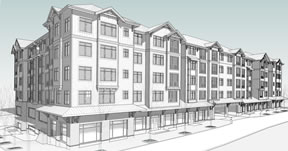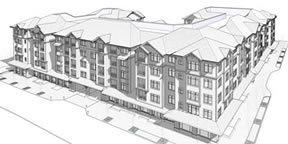Like a recipe, each building project calls for a unique set of ingredients (services) to produce your desired result. Services are chosen to fit your design, site, budget, and schedule needs:
- Feasibility studies – Does this project make sense for what we are trying to do?
- Site selection & analysis – Define requirements to guide land purchase, and research into codes applicable to a specific site
- Site planning & design – possible configurations of the site based on codes and project requirements
- Existing conditions documentation (required in remodel or addition projects)
- Architectural design, documentation, and construction administration
- Permitting (obtaining the necessary permits needed to begin construction)
- ADA & handicapped accessibility planning & design
- 3-Dimensional computer modeling (BIM)
- Kitchen & bath design
Service Phases:
I will develop a detailed description of your goals and needs, review the site and existing conditions, research the applicable zoning codes and planning department requirements and determine how they will affect your project. If the project is an addition or remodel, I will document the existing conditions during this phase.
- Using the information gathered in the program development phase, I create several design ideas that show alternative design approaches.
- You’ll select a design concept that we will refine and develop to create preliminary drawings of the exterior to show the character and style of the building.
- Your contractor can use these schematic drawings to produce a preliminary cost estimate. If no contractor has been selected, hiring a contractor or cost estimator to provide preliminary cost guidelines will help keep the project within realistic budgets.
- Drawings are created that show the design in greater detail. The character and scope of the interior and exterior elements are further refined and developed, and the finishes, materials, and structural systems are reviewed and selected.
- At this stage we identify and select any design consultants that may be needed for your project.
The drawings produced at this stage are detailed and contain detailed information that is required to obtain a building permit, obtain bids from General Contractors, and to provide the General Contractor with information to build the project. These drawings include detailed floor plans, roof plans, exterior elevations, building sections, wall sections, wall type details, door and window schedules, and enlarged construction details. Specifications may be produced depending on the project scope, size, and complexity.
I assist the Owner in making a list of General Contractors for bids. Construction Documents are provided to General Contractors for pricing and submitted for Building Permits. I will meet with contractors to review project drawings and schedules.
I will make job site visits (if part of Owner – Architect contract) to determine if the construction is consistent with architectural drawings. I meet with and answer construction related questions from the General Contractor and provide the Owner with information to assist the Owner in making any decisions during the construction phase
Tools
Computer technology seems to change daily and one of the exciting benefits is that it has allowed us to visualize images of ideas, concepts, and 3-dimensional renderings prior to their being brought into reality.
 So, what does this mean to my clients, Planning Departments, and Contractors? They now have 3-dimensional drawings that show how the building will look with accurate representations of the various forms, shapes, and materials that create a building. These drawings explain the design concept, reduce time during the Building Permit stage, and help the contractor give a more realistic construction price, rather than adding extra dollars to cover the unknown factors the contractor may be unable to visualize.
So, what does this mean to my clients, Planning Departments, and Contractors? They now have 3-dimensional drawings that show how the building will look with accurate representations of the various forms, shapes, and materials that create a building. These drawings explain the design concept, reduce time during the Building Permit stage, and help the contractor give a more realistic construction price, rather than adding extra dollars to cover the unknown factors the contractor may be unable to visualize.
 The 3-dimensional drawings shown here are concepts for a mixed-use project design I recently completed. Once the client has accepted the design concept, these drawings can be developed into more realistic renderings that show building materials, landscaping, trees, sky, people, and cars, all of which make the drawing a more accurate representation of how the project will appear when constructed.
The 3-dimensional drawings shown here are concepts for a mixed-use project design I recently completed. Once the client has accepted the design concept, these drawings can be developed into more realistic renderings that show building materials, landscaping, trees, sky, people, and cars, all of which make the drawing a more accurate representation of how the project will appear when constructed.
Sustainability / Green Building
It’s exciting to be an architect in a time when many new energy efficient ideas, techniques, and products are being developed to create buildings that are sustainable or “green” as it is more commonly known. Many of these techniques have been around in some form for years, others are currently being developed. Some of these existing and newly developed techniques are quite good; some are questionable and often fail to deliver on their promise to reduce a buildings impact on the site, its energy bills, maintenance costs, and the owner’s checkbook.
The most efficient way to design a sustainable / green project is by creating a design that works efficiently with the least amount of building space., which means that less space is required to be built and maintained, energy costs are lower, and less construction waste is produced during construction of the project. These more efficient designs can have spaces that are designed for shared uses, reducing the impact on the site and can save the owner significant amounts of money. Design to respond to the site –attention to site orientation can make significant differences in the costs of heating, cooling, and lighting in a building.
Green buildings can be designed in any architectural styles and do not need to be designed in a style that happens to be popular this year and may not be next year. Higher insulation values, careful sealing of all exterior openings, more efficient mechanical systems, and products with non-toxic finishes are all examples of energy saving techniques that do not affect the exterior appearance of the building, yet can still be very cost effective.
For clients who are interested in remodeling or constructing an addition, I remind them of the saying that “The greenest building is the one already built”. Their existing home or building represents a sizable investment in energy required to originally construct that building. We can definitely improve the layout, appearance, and the energy efficiency. Tremendous energy and costs can be saved if the existing building can be improved, rather than tearing it all down and starting over. In some cases, that may be the best choice but the question “Is this building worth saving” certainly deserves to be considered.
